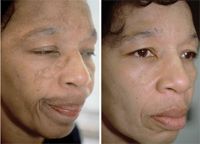- Acne
- Actinic Keratosis
- Aesthetics
- Alopecia
- Atopic Dermatitis
- Buy-and-Bill
- COVID-19
- Case-Based Roundtable
- Chronic Hand Eczema
- Chronic Spontaneous Urticaria
- Drug Watch
- Eczema
- General Dermatology
- Hidradenitis Suppurativa
- Melasma
- NP and PA
- Pediatric Dermatology
- Pigmentary Disorders
- Practice Management
- Precision Medicine and Biologics
- Prurigo Nodularis
- Psoriasis
- Psoriatic Arthritis
- Rare Disease
- Rosacea
- Skin Cancer
- Vitiligo
- Wound Care
Article
Staying the course: Treating melasma a long-term process; regular checks required
Author(s):
"Treatment for melasma involves assessing the patient's skin color, the extent of melasma in each cosmetic unit and the patient's tolerance for irritated skin.

Key Points

Over the span of his career, Dr. Brody estimates that his melasma caseload has exceeded 5,000 patients. He has conducted and published research on a number of treatment modalities.

Before treatment
In the initial consultation, Dr. Brody says, be sure to rule out Addison's disease or thyroid problems.
"These conditions also cause hyperpigmentation, and in the early stages, it looks similar to melasma. However, it isn't treatable until the underlying problem is resolved," he says.
Likewise, he refrains from treating women who have melasma as a result of pregnancy until after they have given birth, and those who are on hormones until after they have stopped them.
If a man has a profession or hobby that involves a lot of sun exposure, Dr. Brody waits until the patient is willing to make changes before starting treatment.
"The patient must use a full-spectrum sunblock - that's axiomatic - and make a commitment to stay out of the sun," Dr. Brody says.
Dark-skinned patients
With Fitzpatrick skin types IV and V, Dr. Brody begins treatment with a hydroquinone preparation (6 percent to 8 percent) mixed with cortisone and retinoic acid. He starts with twice-a-day applications and then reduces to once a day or to a lower concentration, if the patient reports irritated skin.
The next step, he says, is adding an exfoliating agent.
In theory, anything that removes dead cells - a loofah sponge or abrasive pad, cleaning with alcohol or acetone, microdermabrasion, chemical peel, or a laser - will work, if used appropriately.
The trick is finding the sweet spot. With too little exfoliation, the bleaching agent doesn't penetrate adequately. With too much exfoliation, the patient may experience pigmentation rebound, Dr. Brody says.
He warns dermatologists that using lasers will produce erratic results and that an IPL light source can make melasma worse. A fractional laser may help, but the energy must be lowered in darker-skinned individuals to avoid postinflammation pigmentation.
To get consistent and cost-effective results, Dr. Brody uses chemical peels.
His recommendations:
Before peeling, assess the extent of melasma. Peel the entire face, when the patient has melasma on more than 50 percent of each and every cosmetic unit; otherwise, treat only those cosmetic units that have more than 50 percent melasma coverage.
If a cosmetic unit has less than 50 percent pigmentation, peel only the pigmentation, Dr. Brody says.
Use a superficial peel every four to eight weeks, slowly increasing the strength. If the melasma pigment remains, he says, you may need to use a medium or deep peel on isolated cosmetic units.
If the pigment disappears but returns later, prescribe a higher strength of hydroquinone, according to Dr. Brody.
"Dark-skinned patients may require a year of treatment," he says.
Asian and lighter skin
Asian skin is sensitive. Also, because some Asians have a penchant for cleanliness, many tend to scrub hard when washing the face. This can stimulate the production of more pigment, according to Dr. Brody.
Both of these factors can make Asian populations difficult to treat. For best results, Dr. Brody alternates a hydroquinone-and-cortisone preparation with another preparation containing additional retinoic acid, two weeks on and off. He does not peel and cautions patients against too much scrubbing.
For light-skinned patients, he uses bleach alone, because the pigment is usually epidermal. The key is to obtain an adequate degree of penetration, and a 4 percent gel is usually sufficient, according to Dr. Brody.
Hydroquinone
For the past two years, the Food and Drug Administration has been investigating a possible link between hydroquinone and cancer, Dr. Brody says, and it's possible that the agency could ban the ingredient.
"If they do, we will have no way to treat melasma, because other bleaching agents are ineffective by comparison," he says.
A ruling was expected in September.
Disclosure: Dr. Brody reports no relevant financial interests.
Newsletter
Like what you’re reading? Subscribe to Dermatology Times for weekly updates on therapies, innovations, and real-world practice tips.











